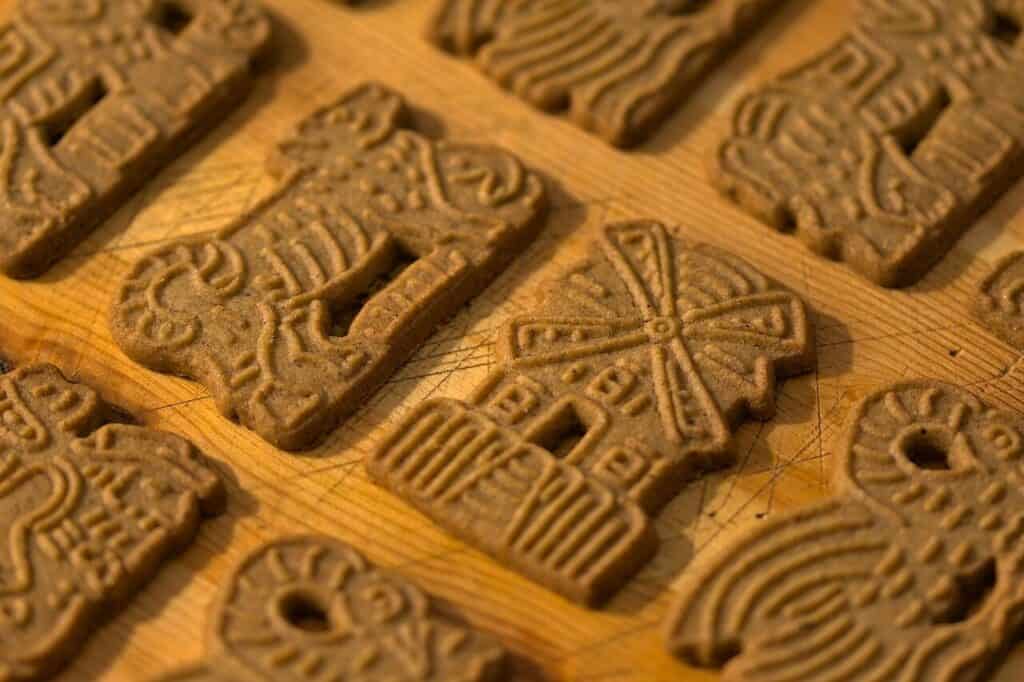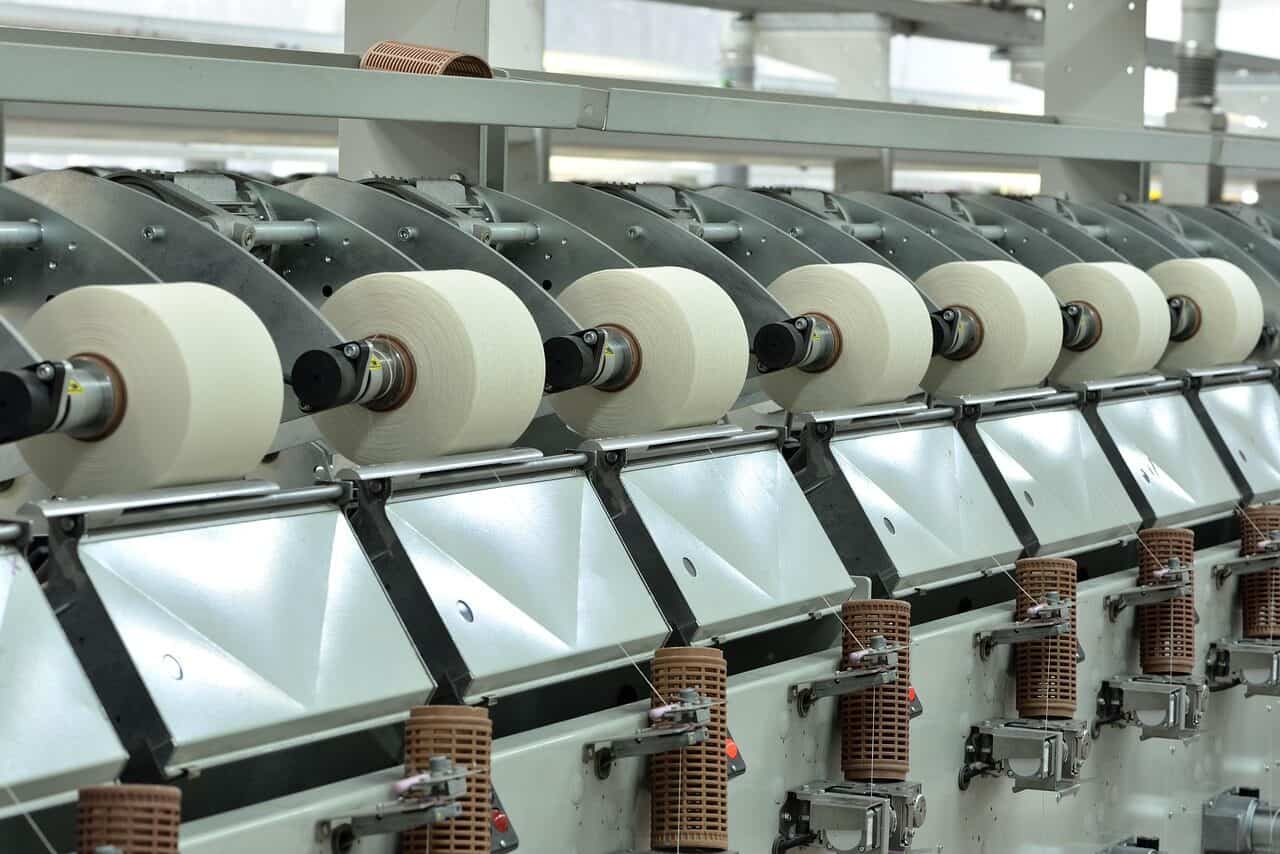ينتج المصنع البسكويت بعدة طرق مختلفة. المكونات الرئيسية للبسكويت هي الدقيق والسكر والدهون والماء والتخمير الكيميائي. تتنوع عمليات التصنيع وتركيبات تركيبة الكوكيز. تجتمع هذه المكونات الرئيسية لصنع البسكويت المثالي. في الواقع، يحتوي البسكويت النموذجي على أربعة مكونات أساسية فقط: الدقيق والدهون والماء والسكر. وتشمل المكونات النهائية مجموعة متنوعة من المكونات الأخرى، مثل عوامل التلوين والمنكهات.
عملية صنع الكوكيز في المصانع

تتضمن عملية صنع البسكويت في المصانع عدة خطوات. أولاً، يتم فرد العجين. ثم، يتم مصبوبة باستخدام ماكينة دوارة أو ماكينة ختم. الختم ماكينات تستخدم العجين الملفوف مسبقًابينما تقوم ماكينات قولبة العجين (FPL) ببثق العجين من خلال قالب بأشكال مختلفة. بعد أن يتم فرد العجين، يتم وضع قطع العجين على قوالب استنسل ساخنة أو سيور ناقلة شبكية للفرن. ثم يتم تعبئة الكعك النهائي في صناديق أو عبوات.
في الخطوط الميكانيكية المتدفقة، يتم تغذية المواد الخام في ماكينات العجن. يتم تحضير العجين من الدقيق والنشا، وكذلك عن طريق تحضير المستحلبات من باقي المواد الخام. يتضمن تحضير المستحلبات خلط سائلين بقوى تماسك بين جزيئية مختلفة. وهذا يضمن أن يكون توزيع المادتين الخام متساويًا ويمكن معالجته بسهولة. بعد خلط العجين، يخضع العجين لفحص الجودة والتعبئة والتغليف.
الخطوة التالية في التصنيع العملية هي عملية تُعرف باسم الخلط. في هذه الخطوة، يتم خلط العجين بسرعات مختلفة لصنع أنواع وأحجام مختلفة من الكوكيز. وحسب نوع الدقيق المستخدم، قد يستغرق خلط العجين من عشر دقائق إلى خمس عشرة دقيقة. بعد خلطها، يقوم العمال بوضعها في صناديق وتغليف البسكويت. وبمجرد الانتهاء، يتم إرسال الكوكيز إلى ماكينات التغليف والتوزيع.
المكونات في البسكويت
تحتوي وصفات الكوكيز على ثلاثة مكونات أساسية: الدقيق والسكر والدهون. وتشمل المكونات الأخرى المخمرات والبيض والسوائل والمكسرات والشوكولاتة. المكونات الطازجة ضرورية لنجاح الكوكيز. عند اختيار وصفة الكوكيز، ابحثي عن الملصق لمعرفة ما إذا كان يذكر "مكونات إضافية".
يُستخدم السكر لجعل البسكويت طرياً ومطاطياً. تعمل الزبدة في البسكويت كمادة تشحيم وعامل تهوية. فهي تحبس خلايا الهواء أثناء الخلط وتعمل كنواة للخمائر الكيميائية. وتعد هذه الخطوة ضرورية للحصول على الحجم والقوام. المحليات هي مكون رئيسي في عجينة البسكويت، وتتراوح نسبتها من 17 إلى 30 بالمائة على أساس صلب. إن أنواع المُحليات المستخدمة تختلف حسب الوصفة.
تؤثر الدهون الأخرى على طعم وملمس البسكويت. تصنع الزبدة كعكة مسطحة تنتشر عند وضعها على صينية خبز ساخنة. لا ينتشر السمن بسهولة ولا يضيف أي نكهة. يتميز السمن بدرجة ذوبان أعلى، لذا فهو يصنع بسكويتاً أكثر انتفاخاً. كما أن السمن أقل تكلفة من الزبدة، ولكن عليك توخي الحذر لأنه ليس بنفس النكهة.
تكلفة صنع البسكويت في المصانع
مصنع يصنع البسكويت لكسب الرزق. هناك طريقتان رئيسيتان لحساب تكلفة البسكويت: عن طريق تقدير تكلفة كل قطعة بسكويت، أو بقسمة تكاليف المكونات على عدد البسكويت المخبوز. والطريقة الأخيرة هي الخيار الأرخص، حيث يمكن أن توفر الوقت والمال. ولكن هناك بعض العوامل الأخرى التي يجب أخذها في الاعتبار عند حساب تكلفة الكعكة الواحدة. على سبيل المثال، يجب أيضًا تقدير المعدات المستخدمة في صنع البسكويت.
في حين أن الكوكيز المصنوعة في المصنع عادةً ما تكون مصنوعة من مكونات أفضل، إلا أنها قد تكون باهظة الثمن. على سبيل المثال، قد تكلف قطعة البسكويت الواحدة $14. ولكن إذا كنت تبيعها مقابل سبعة سنتات لكل منها، فيمكنك أن تتوقع أن تحقق ربحاً لا يقل عن $50 لكل دستة. يمكن لعامل المصنع أن يكسب ما يصل إلى $15 في الساعة. ومع ذلك، لا يستطيع الكثير من الناس تحمل تكلفة توظيف موظف للعمل مقابل هذا الأجر المنخفض. وإذا لم يكن لديك مصنع، فيمكنك دائمًا الذهاب إلى موقع بعيد عن الطريق.
يتطلب تصنيع الكوكيز دقة في التصنيع، بدءًا من خلط العجين وحتى الخبز والتغليف. وفي حالة حدوث أخطاء، قد ينتهي بك الأمر بخسارة المال. ومع ذلك، مع وجود آلات عالية الجودة وموثوقة، يمكنك منع الخسائر وجني أقصى قدر من الأرباح من الاستثمار. لذا، عند التفكير في إنشاء مصنع، ضع في اعتبارك العوامل التالية:
العوامل التي يجب مراعاتها عند إنشاء مصنع كوكيز
1. المعدات والتكنولوجيا
يعتمد نجاح أعمال تصنيع البسكويت إلى حد كبير على نوع وجودة المعدات المستخدمة. وتشمل الآلات الرئيسية خلاطات العجين، وآلات التشكيل الدوارة، وأفران الخبز، وناقلات التبريد، وآلات التعبئة والتغليف. تستخدم المصانع الحديثة أيضًا خطوط التدفق الآلي مع أنظمة التحكم PLC لتحسين الكفاءة والاتساق. يساعد الاستثمار في الأفران الموفرة للطاقة وأنظمة الوزن الدقيقة على تقليل التكاليف والحفاظ على جودة المنتج.
2. المواد الخام وسلسلة التوريد
من الضروري توفير مصادر موثوقة للمواد الخام مثل الدقيق والسكر والدهون والمنكهات. وينبغي أن يكون الموردون قادرين على توفير مكونات غذائية تفي بمعايير السلامة. يمكن أن يساعد إبرام عقود طويلة الأجل مع الموردين المحليين على استقرار الأسعار وضمان استمرار الإنتاج. بالإضافة إلى ذلك، فإن الحفاظ على نظام تخزين فعال يساعد على منع تلف المكونات وهدرها.
3. مراقبة الجودة وسلامة الأغذية
يجب تطبيق مراقبة الجودة في كل مرحلة - بدءًا من اختيار المكونات وتحضير العجين إلى الخبز والتعبئة والتغليف. ويشمل ذلك مراقبة درجة الحرارة ومحتوى الرطوبة واتساق الوزن. يجب على المصانع اتباع إرشادات نظام تحليل المخاطر ونقاط التحكم الحرجة (HACCP) والامتثال للوائح المحلية لسلامة الأغذية. تضمن عمليات التفتيش الروتينية والفحوصات المعملية الروتينية أن الكعك يفي بالمعايير المطلوبة من حيث القوام والطعم ومدة الصلاحية.
4. التعبئة والتغليف والعلامة التجارية
لا تحمي العبوات الجذابة والوظيفية البسكويت من التلف والرطوبة فحسب، بل تعزز أيضًا من جاذبيتها في السوق. تحظى خيارات التغليف المرنة مثل الأكياس والصواني البلاستيكية وعلب الصفيح بشعبية كبيرة. يجب أن يعكس تصميم العبوة هوية العلامة التجارية ويعرض بوضوح المعلومات الغذائية وتواريخ انتهاء الصلاحية. تزداد أهمية مواد التعبئة والتغليف المستدامة مع ازدياد وعي المستهلكين بالبيئة.
5. إدارة العمل والإنتاج
يتطلب مصنع البسكويت عمالاً مهرة لتشغيل الماكينات وصيانتها وضمان الجودة. تضمن الإدارة الفعالة للعمالة اتساق الإنتاج وتقليل وقت التوقف عن العمل. يجب تنفيذ برامج تدريبية لتعريف الموظفين بمعايير السلامة وممارسات النظافة وتقنيات الإنتاج الحديثة. يمكن أن تساعد الأتمتة في تقليل تكاليف العمالة، ولكن يظل الإشراف وفحص الجودة أمرًا ضروريًا.
6. طلب السوق والتوزيع
قبل إنشاء مصنع لملفات تعريف الارتباط، من المهم البحث عن طلب السوق وتفضيلات المستهلكين. يمكن وضع ملفات تعريف الارتباط كوجبات خفيفة بأسعار معقولة، أو منتجات متميزة، أو بدائل صحية المنحى حسب الجمهور المستهدف. وقد تشمل قنوات التوزيع محلات السوبر ماركت، والمتاجر الإلكترونية، والمتاجر الإلكترونية، والمتاجر الصغيرة، وأسواق التصدير. إن إقامة شراكات مع تجار التجزئة وتجار الجملة يضمن استقرار المبيعات وظهور العلامة التجارية.
7. التخطيط المالي والاستثمار
يتطلب إنشاء مصنع للكعك استثمارًا رأسماليًا كبيرًا. وتشمل النفقات شراء المعدات ومساحة المصنع والمرافق والعمالة والتسويق. وتعد دراسة الجدوى التفصيلية وخطة العمل ضرورية لتقدير تكاليف بدء التشغيل والقدرة الإنتاجية ونقاط التعادل. يمكن أن تساعد المراقبة المستمرة للتكاليف وتحسين الإنتاج في زيادة الربحية إلى أقصى حد.
8. الاستدامة والابتكار
تركز مصانع البسكويت الحديثة بشكل متزايد على الاستدامة - تقليل استهلاك الطاقة، وتقليل النفايات، والحصول على مواد صديقة للبيئة. يمكن أن يساعد الابتكار في النكهات والقوام والمنتجات الصحية (مثل البسكويت الخالي من الغلوتين أو البسكويت منخفض السكر) العلامات التجارية في الحفاظ على قدرتها التنافسية. ويتيح الاستثمار في البحث والتطوير ابتكار وصفات وتغليف جديدة تلبي احتياجات المستهلكين المتطورة.
استنادًا إلى نتائج بحثي، إليك 10 روابط خلفية موثوقة لملفات تعريف الارتباط وتصنيع المخبوزات مع DA 40+:
- https://www.fda.gov/ إدارة الغذاء والدواء الأمريكية - إرشادات سلامة الأغذية ونقاط التحكم الحرجة في تحليل المخاطر ونقاط المراقبة الحرجة لمنتجات المخابز
- https://www.ams.usda.gov/ وزارة الزراعة الأمريكية - معايير عجينة البسكويت ومنتجات المخابز
- https://bakerpedia.com/ باكيربيديا - عمليات إنتاج الكوكيز وخبز الكوكيز
- https://www.ift.org/ معهد تقنيي الأغذية - HACCP في المخابز
- https://www.iso.org/ ISO - معايير إدارة الجودة لتصنيع الأغذية
- https://en.wikipedia.org/wiki/Cookie ويكيبيديا - كوكي
- https://www.sciencedirect.com/ ScienceDirect - بحوث المخابز وتجهيز الأغذية
- https://www.ifsqn.com/ IFSQN - شبكة سلامة وجودة الأغذية - IFSQN - شبكة سلامة وجودة الأغذية
- https://www.slideshare.net/ SlideShare - العروض التقديمية لسلامة الأغذية وممارسات التصنيع الجيدة للمخابز
- https://www.researchgate.net/ بوابة الأبحاث - أوراق بحثية عن صناعة المخابز - ResearchGate








